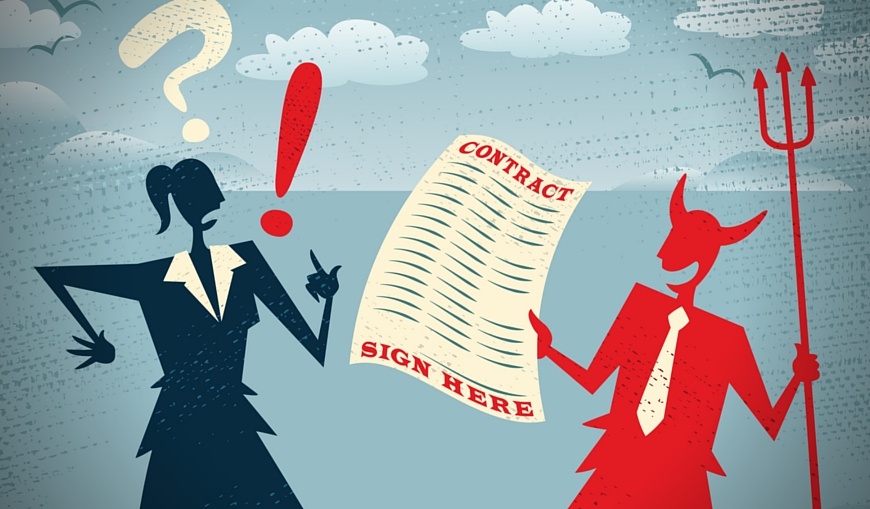Entering a binding contract with a sea witch, forest witch, or any other sorceress is not required to get clickable posts. If you’re selling your soul to get your content read online, you’re doing it wrong.
Shift your focus and ambition, instead, to creating attention-grabbing headlines. They’ll prove more effective long-term than any saccharine or bombastic clickbait headline.

I am assuming, of course, that you are shooting to get your content read beyond the headline itself to power a well-rounded, enduring, effective content strategy. You’ve probably heard that two of ten people will completely read your post, while the remaining eight will only read your headline. If your aim is simply to get clicks, on the other hand, this will not be a helpful post for you.
First, let’s direct our attention to what constitutes a good headline in the current state of affairs, then build on that solid foundation to improve it from good to great, and thus—clickable.
(And yes, these may surprise you. But actually.)
What’s a Good Blog Headline?
First things first. Logistically, the baseline requirements for headlines are:
- Requirement: 6-10 words in length. Max. Cut out any potentially superfluous words.
- How to get there: Write out 10-15 headlines each time. Run ’em through a headline analyzer (we recommend and love CoSchedule’s free one)—that will help inform this exercise in making each as punchy as possible.
- Requirement: No longer than 60 characters. If you want to get exact, 55 is the sweet spot to satisfy both SEO purposes and short-attention-spanned humans.
- How to get there: Think of it like a tweet. You CANNOT exceed the character count or else it won’t publish. Another tip is to avoid the passive voice. It’s wordier.
- Requirement: Include ranking keyword or exact phrase of topic.
- How to get there: First, a warning: The days of keyword stuffing are oooooo-ver. So any awkward, unnatural language, even if it’s part of your ranking keyword/topic, should be avoided at all costs. If you’re confusing a reader with the headline, it’s effectively functioning like this sign:

Would you go in there, having NO idea what you’re in for? I sure wouldn’t.
And most importantly:
- Requirement: A headline should, above all, provide a clear idea of what is contained in the post to follow. Respect your reader.
- How to get there: This is exactly the opposite of a clickbait-style headline. Need some examples? Think bracketed information on the form of the post (i.e. [Podcast], [Infographic]) or a quantified list to give the reader a good idea of length/depth of post (i.e. 30 Blog Post Ideas For When You Don’t Know What To Write About).
Got it? Now, onto how to take these post headlines to the next level.
Elevate Headline from Good to Great, Enter Attention-Grabbing Headlines
Writing The Great Blog Headline. It’s a tall order. And in the content landscape of today, when the vast majority of readers are finding material to consume through a series of social feeds, brevity runs the show.
A quick aside. Two months ago, I didn’t know any of this in-depth stuff about headlines. One could say that’d make me the ideal person to write on how to start from scratch and improve headlines from good to great. That remains to be determined.
Further, the blog team has focused on a new tactic to optimize our blog each month, and this past month was all about headlines. And while headlines for our posts are still nowhere near as clickable as Buzzfeed or Upworthy, we’re certainly heartened by the gradual, incremental progress we’ve been able to make in the past 30 days alone.
It goes to show that anyone can experiment and make changes at any time (even five years in!). The best catalyst to progress without experience is starting somewhere, feeling it out, and adapting as you go.
Keep the foundational, baseline principles in the above section top-of-mind in the next steps to elevate your headlines to clickable greatness. Because there’s plenty of clickbait out there, the next task for any reader after you’ve gotten their attention is centered around determining a post’s value from the headline.
Here are the best seven tactics to garner attention without stooping to clickbait, while also simultaneously conveying post value:
1. Know the weight of the first & last three words of a headline.
Psychologically, the first three AND the last three words of your headline have the highest impact. Think about it: It’s both an audience’s first impression of a post, and the most likely take away as the most recent information presented (and usually most easily accessed by the brain later).
CoSchedule’s headline analyzer helps isolate the first and last three words of a headline in its free analysis of headlines. Check it out, and position your words carefully for maximum effect.
2. Shoot for six words as the sweet spot.
Building on the tactic listed above: If you can convey what’s contained in a blog post in six words, the strong retention effect of the first and last three words will encompass the whole headline. The dream!
3. Communicate strong sentiment.
This makes sense, too. Humans are drawn to the emotionally charged events and content over generic, toneless pieces.
Okay, but which strong sentiments work? If you boil it down, the sentiments that perform best in headlines are surprise and curiosity.

Shock or fear perform well, too, but you have to especially be careful about using those. As human’s strongest feelings, shock/fear is also the most abused angle by clickbait content. It’s a red flag now for most savvy content consumers.
4. Don’t be afraid to bust out negativity.
This may seem counterintuitive—how would you attract quality traffic to your blog and entice readers by putting out a negative headline?
Think of it in this way: What pain points/mistakes do your readers want to avoid? What don’t they want to be? Sometimes it takes highlighting the worst examples of something to teach a lesson on best practice.
5. Pepper in power words.
Having a master list of power words to pull from is an essential resource. Here’s the perfect doc to have on hand.
Pepper these in when experimenting—they’ll definitely differentiate your titles for the passerby.
6. People care more about the ‘whos’ than the ‘whys’.
‘Why’ is out. ‘Who’ is in.
Of any other tactic studied here by HubSpot, the greatest increase in click-throughs to posts by far was when ‘who’ was included in the headline. Ground perspective in other human experiences, and that will resonate.
7. Avoid words that are saturated in the space.
Which words are those, you ask?
- Your
- Superlatives like ‘best’, ‘always’, ‘amazing’
- Tips
- Easy
- Simple
- Secret
- Need
All of these words, when used in headlines, have shown to decrease click-through rates on posts.
The bottom line: Provide value, aim not to sensationalize. Readers are wisening up. Think editorial, not advertorial. And respect your reader.
Do you have any other tips for how your company or agency writes headlines? I’d sure love to hear about it! Shoot me a note on the social channels in my bio below..
In case you’re looking for more headline-optimizing fodder, these’ll keep you busy for a while:
Other Resources
- https://www.quicksprout.com/2014/07/03/the-formula-for-a-perfect-headline/
- https://blog.bufferapp.com/headline-strategies-psychology
- https://stories.buffer.com/30-ultimate-headline-formulas-for-tweets-posts-articles-and-emails-2a00fd69f680#.apoq7vroi
- https://blog.bufferapp.com/clickable-headlines



